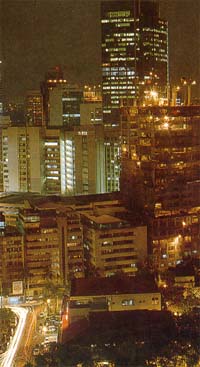|
Manila, the
Philippine capital, is the political, social, cultural, religious, educational, industrial
and commercial center of the country. Sightseeing and shopping are the main tourist
activities. A tour of Intramuros, Spanish walled city of Manila, will provide the visitor
a deeper understanding of Manila's rich heritage.
It is also the country's largest
city and the second-largest metropolitan area in Southeast Asia (second only to Jakarta in
Indonesia). It is situated in southern Luzon, beside Manila Bay. The Pasig river flows
through the city and empties into the bay which covers an area of 770 sq mi (2,000 sq km).
Manila Bay is considered one of the finest harbors in the far east.
In 1975, the city of Manila was
merged with 16 surrounding communities (including the former national capital, Quezon
City) to form a single governmental unit. The city proper has a population of 1,876,194
and the National Capital Region spanning an area of 636 sq. km. has a population of
7,832,000 (1990).
Majority of Manila's population
belongs to the tagalog-speaking group, although recent migration from rural areas
increased the percentage of other ethnic groups. About 6% of the population are Chinese
and close to 95% of the population are Roman Catholics (considerably higher than the
national average).
Manila's diverse industries include
chemical, textile, shoe, rope and coconut oil manufacturing, as well as shipbuilding, food
and tobacco processing. Because of its fine and highly protected harbor, Manila serves as
the principal port for the Philippines. It is also the financial and publishing center of
the nation. Many universities can be found in its metropolitan area including the
University of the Philippines (1908) and the University of Santo Tomas (1611).
Noteworthy landmarks include the
National Museum, Rizal Park (located by the bay), the presidential palace, San Agustin
Church (built in the 16th century), and the walled city of Intramuros.
The choice of entertainment in
Manila displays the Filipino's affinity for music. 5-star hotels offer everything from
high-tech discos to lavish cultural songs and dances, as well as superb pop singers and
performers, trios, show bands and classical string ensembles. On most evenings there are
cultural performances by local artists or foreign groups at the many other venues for the
performing arts. Free concerts are offered by several parks every week, and occasionally
by banks and other corporations.
Manila, like most of the world's
large cities, suffers from a huge and problematic urban sprawl. Typically, urban sprawl
also creates nightmares for travellers, however the main points of interest to visitors in
Manila are centralised, making suburban navigation unnecessary. Manila sprawls east from
Manila Bay along the Pasig River, and immediately south of the river is Intramuros, the
old walled Spanish town where many of the city's historical sites are found. Further south
again and you'll find yourself in the 'tourist belt' of the Malate and Ermita districts,
where you'll find restaurants, accomodation and travel agencies.
Arriving in Manila's Ninoy Aquino
International Airport is about as far as you'll ever get from a streamlined process. No
matter how hard they try, Filipinos are unable to get their airport to work. Poor signage,
crowds and an illogical layout all contribute to the chaos, but if you're confused, you
won't be alone. Once you finally make your way to the street, things begin to look up. The
airport, only about 8km (5mi) south of the centre of Manila, is well-served by buses and
taxis, and there is a metrorail station about 2km (1.2mi) away.
|
|



METRO MANILA PHOTOS
|